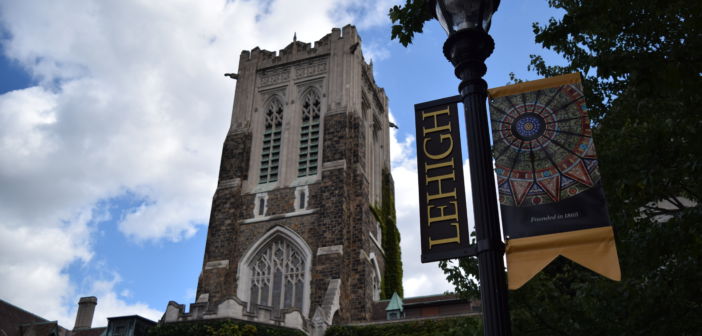Lehigh University’s board of trustees has approved a 4.3 percent increase in tuition for the 2018-2019 academic year, according to the Office of Finance and Administration.
According to the post, tuition will increase by $2,160 — from $50,320 to $52,480.
“The total cost of attending Lehigh as an undergraduate — including tuition, typical room and board charges, and the undergraduate technology and activity fees — will be approximately $66,730,” the post read.
Lehigh’s tuition has been on the rise for the past several years.
Last year, the university announced its largest tuition increase since 2008 when it raised tuition by 5 percent — or from $47,920 to $50,320 — for the 2017-2018 academic year. The total cost of attendance for a first-year student was listed between $64,060 to $64,610.
Tuition was raised 3 percent, or $1,340, for the 2015-2016 academic year, resulting in a total cost of $58,510. Tuition was also increased by 4.5 percent for the 2016-2017 academic year. This meant students had to pay an additional $2,060, raising the cost of tuition from $45,45,860 to $47,920, with a total cost of attendance of $61,010.
According to the most recent announcement, “The university is (also) committed to providing financial assistance to students in need.”






Comment policy
Comments posted to The Brown and White website are reviewed by a moderator before being approved. Incendiary speech or harassing language, including comments targeted at individuals, may be deemed unacceptable and not published. Spam and other soliciting will also be declined.
The Brown and White also reserves the right to not publish entirely anonymous comments.
8 Comments
AHAHAHAHA don’t go there.
Don’t go where Amy?
The total estimated cost of attendance of your current institution, The University of Iowa, is $22,831.50 for in-state students and $44,475.50 for out-of-state students. See https://admissions.uiowa.edu/finances/estimated-costs-attendance. While Lehigh University does receive government research grants and contracts, it does not receive taxpayer subsidies from the Commonwealth of Pennsylvania as The University of Iowa would from the State of Iowa.
Get off your high horse.
Don’t go to Lehigh. Don’t go to any school that’s going to charge you anything like $67K for 32 weeks of classes. We wore through “obscene” as a useful descriptor of charges like that maybe twenty thousand dollars ago. Lehigh now costs more per year than median household income.
As for Iowa, the costs here are also far too high now, and they’ll go higher — though here, at least, an entire legislature has to agree to let them raise tuition, not just a bunch of financiers for whom $67K is a summerhouse rental and light catering. Iowa is supposed to be a public institution, and for a very long time it behaved like one. As recently as the late ’90s, early aughts, you could go to school here for something approaching reasonable. It was a pretty good school, too. Now we’ve got people this state U’s meant to serve who are unable to go to college at all: it costs too much, in part because a layer of people working for this place, like similar layers of people at other public Us, decided that means “great way to get rich(er)” rather than “I do public service here”. The institution itself is also being progressively hollowed out to serve people who mistakenly think there’s a buck to be made here.
It’s a remarkably Lehighlike frame of mind, and it’s destroying public education in this state. Which is a pity, because public ed here used to be impressively good despite the fact that Iowa has never been a particularly wealthy place. When I got here in the early ’90s I found that my students were much better-prepared academically, harder-working, and certainly nicer than Lehigh students were. It’s a different story now (though they’re still very nice, and most are hardworking), and their continuous state of money-related panic/dread overrides almost everything else. Why? Greed. You can get a lot fancier in the analysis but end of the day it just comes down to that. Greedy people who feel entirely self-justified in greed and even criminality, and are thin-skinned about it, too. But they’re putting whole generations through hell and crippling a lot of those families.
What probably comes next is what they’ve been trying elsewhere: actual indentured servitude. Someone else — not taxpayers, but some private entity trying to skin the kids here — pays the gap between COA and borrowable money, picks their major for them, and then for some span of years the kids owe those firms a hefty chunk of their income. Whatever jobs they might do, they effectively work for the firms that paid part of the tuition; the firms own them for cheap. Stupid kids for choosing the wrong parents.
Nobody should pay $44K to go here, either.
I recognize that a whole lot of upper-middle-class students, particularly in the northeast, have been taught from early childhood that if they don’t go to A Good School, meaning as close to Ivy as you can get, they’re going to die in the gutter wearing a Goodwill shirt. That’s probably truer now than it’s been in a hundred years, but it’s still not true enough to be worth what’s getting on for $300K, especially if the word Prince doesn’t come before the rest of your name. <– a laughable thing to have to say. Kids go to Penn State and Rutgers and SUNY schools, and even Iowa, and wind up with friends and careers and homes and the rest of the usual.
I also recognize that there's a certain helplessness for current students and kids and families approaching college. The kids have to go to college. College anywhere in the US costs money so gigantic it can deform the rest of your life and get your parents into serious trouble — which again means you, because in the end you'll be looking after them. There's nothing you can do about that for yourself. But there's still a choice here. You can pretend all of this is reasonable and the-way-it-is and fine and get very angry at people who say it's not, or you can be eyes-open about it, accept that you can't evade the screwing, but recognize that this is destructive and wrong and greed-based, and think about how you're change things. There are things you can do about it for future generations, including your own kids. And in the meantime you don't have to accept more of a screwing than is strictly necessary.
So no, if you're not so rich you can't feel the ground, don't go to Lehigh, and don't fix it so admin at some expensive school gets to play games with fin aid you desperately need. They know the games better than you do anyhow, and it's their house. Or, if you want to roll those fin-aid dice, know your limit and once the COA goes above it, say goodbye and go enroll in-state at a public U for the rest without regrets. Don't let them extort money you don't have. Otherwise just go to a public university from the start, get a reasonable ed and take some initiative in doing your networking rather than hoping Lehighlike concierge service will do what you need, and note what's wrong at your school, what isn't working. Then vote for people who will fund those institutions adequately and reduce state-U tuition, so that you'll have the pleasure of living with a generally well-educated populace and your own children won't have to go through this insanity.
I’ve read a few of Amy’s comments lately. While they are typically far too wordy, snarky and bitter for my taste, I’ll also say there is always a kernel or two of truth buried in them….if you can find it.
This one, though, is spot on. I agree 100%.
Lehigh is a great school but it is very expensive. I would say too expensive right now. It may be better to do exactly what Amy said by considering your local public U. Even better to maybe take advantage of the ever increasing opportunities offered by your local community college for the first two years.
Yep. If you do that, though — go the cc route — just make sure that the level of what you’re learning syncs with the university’s. Otherwise you get to junior year at university and odds are decent you’ll get a roundhousing and a very messy transcript, and you’ll wind up having to repeat courses. They’ll tell you at the cc that the courses and expectations are the same (they aren’t and they can’t be), but if you talk to the faculty who routinely teach the required junior-year/advanced university courses they’ll give you a pretty good idea of what the cc students are generally lacking by junior year, and how you can try to make up for that ahead of time.
This tuition increase is sick. Lehigh is so proud of its GOLF center, as if it was a country club. It’s clear the focus has been lost regarding the important factors of a college education. Too many colleges sell themselves now like Mercedes-Benz sells cars…look at all the luxuries, bells and whistles. The result is Lehigh is abandoning the middle class student who qualify for little financial aid and whose parents aren’t willing to lose their entire life’s savings to the Bursar.
Lehigh’s tuition AFTER INFLATION is now 2.5x higher in real terms than when I graduated in the 1980s. Sorry, Lehigh, but you are not 2.5x better than in the 1980s, not 1.5x better, maybe 1.2x. This price gouging will encourage the fantastic growth and improve the student body quality at Penn State and Rutgers. REAL LEADERSHIP by Lehigh would be to freeze tuition for the next four years and cut all the excess administrators and their salaries.
RJ—The golf center is, like, a driving range and a putting green. It’s not an 18 hole, or even a 9 hole, golf course. Chill.
Here’s what’s changed since the 1980s:
Colleges and universities across the country have become more “full service” if you will and have doubled or tripled their student services and staff in areas of student affairs, student academic and disability support, and other student experience programs (study abroad, distinctive academic programs, etc.) that just quite frankly didn’t exist “back in the day.” All of those services and programs need to be administered by qualified folks, which costs market-rate salaries and comparable benefits. Fraternities and sororities are out of control? Well, the Office of Fraternity and Sorority Affairs has to hire 1-2 more staff to wrangle them. More first generation college students are coming to Lehigh? You need an additional counselor or two to help make that transition. Lee Iacocca sponsors an international internship program and Lehigh puts more effort on study abroad? Someone has to process the applications, interface with employers, and help place students. Lehigh develops Mountaintop Campus into a world class new product development and entrepreneurial hub? We’ll need more faculty and staff to run the programs, oversee projects, and sweep the floors. In addition to those programmatic bells and whistles, more and more colleges at Lehigh’s level (the higher tier but not-quite-Ivys) have had to become competitive in their facilities—gyms, classrooms, residence halls, dining halls, student centers. Prospective students (but more so their parents) have become consumers, especially those who are paying full freight for their college experience. Just think about the privileged standard that someone who can pay $60,000 per year for college would expect and extrapolate that out to then comparing schools—”Emory has a brand new building for their business school with a state of the art financial services lab, can Lehigh beat that?” Lehigh has to justify its price tag and existence in comparison to peer institutions somehow. We’re competitive now—yay! Oh wait, applications are increasing. We don’t have the hands to process and read all of the applications. We need to hire more admissions counselors, which again costs market-rate salaries and comparable benefits for now more qualified folks. Then, with that growing price tag, Lehigh is pricing out over 50% of its students, who will now need to be supported by financial aid. Admissions should just admit more people who can pay full price. Wait, Lehigh’s admissions process is “need blind” so that admissions does not discriminate against applicants who might not be able to pay full price? Damn. To make things more difficult, Lehigh took the Ivy pledge, which many of Lehigh’s peer institutions have done, to cover 100% of all of its students’ demonstrated financial needs, further increasing its annual operating budget. How do we offset that? Add to the endowment and increase annual fundraising efforts. Well the Office of Advancement then needs to hire more staff to generate those donations, which AGAIN costs market-rate salaries and comparable benefits for MORE qualified folks. That’s not enough? Squeeze a little more out of the <50% of families who can pay full price for Lehigh. They can afford it. And if they can't, Lehigh will make up their deficit by virtue of its pledge to meet 100% of demonstrated financial need, perpetuating the cycle further.
TLDR: A lot has changed since the 1980s.
Uh…yeah. You know, you might be able to slather that on people who don’t work in the industry as an excuse for sixty. seven. thousand. dollars. a year. Maybe. Those of us who’ve been riding along with the changes since the 80s have a better sense of what proportion of that increase should actually be showing up in the price tag for anyone. And the answer is “not a hell of a lot”.
The standard excuse for the tuition hikes throughout the 90s was “we have to compete for hotshot faculty, who will draw the best students and make us ultracompetitive!” Which was nonsense on its face because that’s how almost no undergrads pick universities, but these fictional hotshot faculty supposedly wanted, I don’t know, a Gehry building apiece. Mysteriously, at the same time we had this hyperventilating national campus-improvement marathon for the rara avis PhD wunderkinds who were being pumped out of PhD programs by the truckload, like to the point where there were 500-700 applicants for every humanities job, we also sprouted whole new taxonomies of administrators, usually quite expensive ones. And whole new development staffs for raising billion-dollar endowments that were for…well, nobody quite knew, but goodness, they did generate revenue. To the point where the feds became rather severe about it. And of course the development staffs needed shiny new buildings because you don’t want to bring donors into that old dump that served the old donors perfectly well, do you. And…well, another interesting thing started percolating around the late 90s, early aughts.
That interesting thing was very large new debt-sales enterprises. An awful lot of universities got sold on the idea of massive new sports and fitness facilities, massive and rather fancy new dormitories, all kinds of *buildings*. It was an interesting setup the bond raters had for this: they sent people to examine the “physical plant”, meaning campus, and the shinier your campus, the better your ratings were likely to be. Best replace that old heap. Did I mention how many finance and real estate people sit on Lehigh’s board of trustees?
Now, while the schools were busy selling that argument you’ve got up there, about how rich kids want a personal loofah-down in the private dorm room with the gold fixtures (curiously, they didn’t seem interested in these things till the universities started pushing them; you should’ve seen the dumps where my rich Lehigh boyfriend kept all his rich-kid gear, or, my personal favorite, the apartment of the Bear partner’s daughter who lived over the Ho with her row of dildos on display in the window; it made a nice contrast for when Alex the driver showed up in the Jag to take her home), we started hearing these muffled cries from actual students and actual parents about how they couldn’t afford this. Oddly enough this didn’t dent institutional enthusiasm for the shiny new buildings.
Now perhaps we should talk about rankings games and the way that the universities participate in these games, and who they pass those costs along to. Answer: not just the rich kids.
Or maybe we should talk about the fin-aid games involved in promising some kid that oh sure, the private-school money’s totally there to make up for that $67K pricetag, full need, you betcha. Perhaps we should talk about how many of those kids find that there’s a long way to go between what the U decides is “full need” in sophomore, junior, senior year and paying those astronomical large bills. I just had a conversation a couple weeks ago with a grad student who’s got $72K in “full need” debt. She’s got life insurance at the age of 25 because her dad had to cosign on those loans, and if she dies he has to be able to pay them. That’s what they’re having to think about: *if she dies, the bank will come for her dad*. Was it because she wanted a swank dorm room? No. Or because she wasn’t all that bright? No; she’s pretty sharp. (Or because she was buying every iphone she laid eyes on? No. She’s quite a sensible and thrifty person.) She was actually there for the program and the faculty. Like a student who’s actually serious. But I will eat this desk if any of her faculty were getting paid money that justified her $72K debt, and I’m sure they’d roar with not especially pleasant laughter at the idea.
Maybe we should also talk about erosions of staff and faculty benefits over the years. (What percentage is the tuition benefit now?) Or what it actually costs to process the masses of applications that Lehigh, like every other school, encourages not because they want the very best kids but because it gives the illusion of competitiveness. Or what it actually costs to hire more custodial staff as a percentage of tuition to clean up after larger classes. (Because I guess in higher ed economy of scale is somehow not a thing, despite all the staff and fac who’re told to just deal with much larger class sizes and advising loads for little or no increase in pay.)
Or maybe we should just look an awful lot harder at where large slices of the increase since the 80s actually goes, and why. Takehome: if you find yourself parrotting university admins’ justifications for society-mangling higher-ed costs, just hold on a minute and ask yourself why you’re so eager to buy the lines.
TLDR: Baby plz.